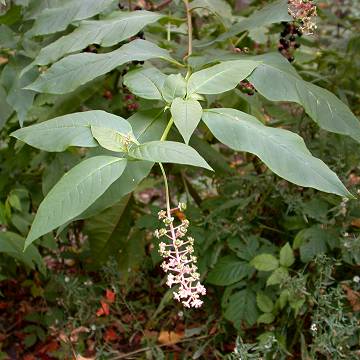

Phytolacca americana - (image 1 of 5)
Taxonomy
Family: Phytolaccaceae
Habitat
Typically in disturbed habitats, such as heavily trampled woods; in open woodland where trees have been removed or burned; shaded, sloping hillsides; mucky marshes under rapid successional change; derelict land; floodplains.
Associates
On shaded disturbed ground with Circaea lutetiana canadensis, Eupatorium rugosum, Galium aparine, Geum canadense, Hacklia virginiana, Laportea canadensis, Parthenocissus quinquefolia, Pilea pumila, Polygonum virginianum, Vitis riparia. In some moist shaded situations with Impatiens capensis and I. pallida.
Distribution
New England west to IA, NE, and south FL to TX. Introduced to the west coast where it is considered a weed.
Morphology
Robust, herbaceous perennial, to 10' high. Leaves alternate, simple, entire, elliptic-lanceolate, glabrous, to 12" long. Stems green to reddish, glabrous, terete. Flowers to 1/4" wide in drooping racemes from the axils of leaves; petals reduced or absent; sepals 5, greenish-white, petal-like. Fruit a purple-black berry, to 1/4" wide, on reddish stems.
Notes
Flowers mid June to mid October
Wetland indicator: Facultative
Most parts are the plant and especially the roots are reputed to be quite poisonous. Poisoning can cause severe stomach pain, vomiting, diarrhea, labored breathing, convulsions and possibly death. Fatalities have occurred from children eating the berries. Robins that eat the berries often act as if intoxicated.
Despite these concerns, the young shoots are reportedly good if boiled for 20-30 minutes in at least two changes of water. The juice of the berries was used by colonists as a dye and an additive to wine.
References
Foster, S. and R.A. Caras. 1994. A Field Guide to Venomous Animals and Poisonous Plants: North America North of Mexico.
Houghton Mifflin Company. New York, NY. 244 pp.
Niering, W. A. 1979. The Audubon society field guide to North American
wildflowers: eastern region.
Knopf/Random House, New York.
Peterson, L. A. 1977. A Field Guide to Edible Wild Plants: Eastern and central
North America
Houghton Mifflin Company. New York, NY
Swink, F. and G. Wilhelm. 1994. Plants of the Chicago Region.
Indiana Academy of Science. The Morton Arboretum. Lisle, Illinois.
|
Michael Hough © 2005 |